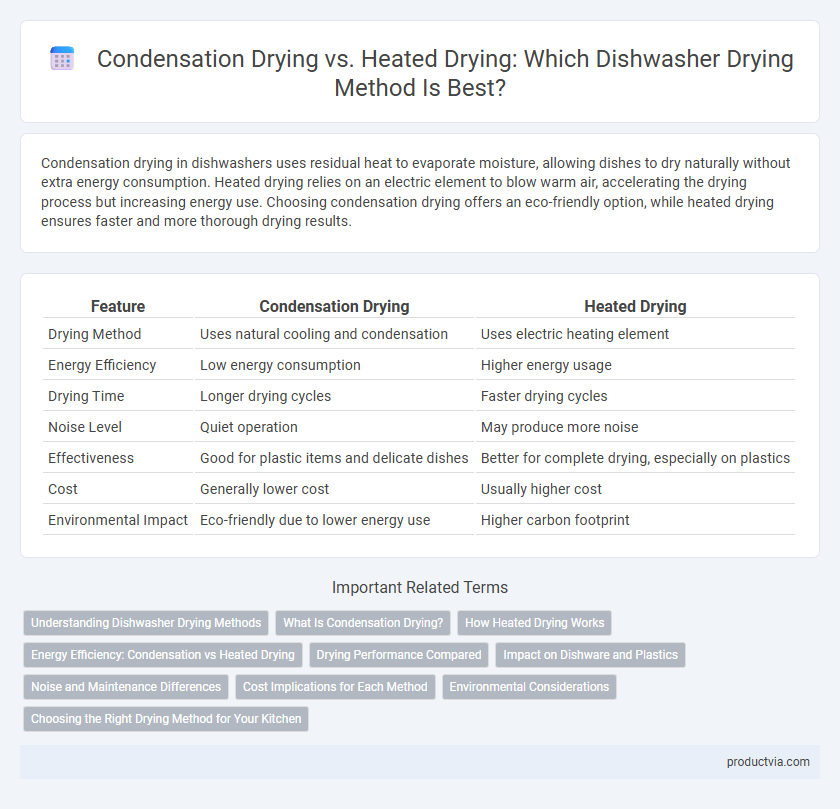Condensation drying in dishwashers uses residual heat to evaporate moisture, allowing dishes to dry naturally without extra energy consumption. Heated drying relies on an electric element to blow warm air, accelerating the drying process but increasing energy use. Choosing condensation drying offers an eco-friendly option, while heated drying ensures faster and more thorough drying results.
Table of Comparison
| Feature | Condensation Drying | Heated Drying |
|---|---|---|
| Drying Method | Uses natural cooling and condensation | Uses electric heating element |
| Energy Efficiency | Low energy consumption | Higher energy usage |
| Drying Time | Longer drying cycles | Faster drying cycles |
| Noise Level | Quiet operation | May produce more noise |
| Effectiveness | Good for plastic items and delicate dishes | Better for complete drying, especially on plastics |
| Cost | Generally lower cost | Usually higher cost |
| Environmental Impact | Eco-friendly due to lower energy use | Higher carbon footprint |
Understanding Dishwasher Drying Methods
Condensation drying in dishwashers relies on natural cooling and moisture absorption, reducing energy consumption by using residual heat to evaporate water from dishes. Heated drying employs an electric heating element to speed up the evaporation process, offering faster drying times but increasing energy usage. Understanding these drying methods helps consumers balance efficiency, performance, and environmental impact when selecting a dishwasher.
What Is Condensation Drying?
Condensation drying in dishwashers uses residual heat to evaporate water from dishes, allowing moisture to condense on the cooler stainless steel walls and then drain away. This energy-efficient method avoids extra heating elements, reducing electricity consumption compared to heated drying. Condensation drying is quieter and gentler on dishware, making it a popular choice in modern, eco-friendly dishwasher models.
How Heated Drying Works
Heated drying in dishwashers uses an electric heating element to raise the temperature inside the tub, accelerating water evaporation from the dishes. This method actively dries dishes by converting residual moisture into steam, which then vents or condenses for removal. Heated drying is effective for quickly achieving dry cookware, especially plastics that retain water droplets during condensation drying cycles.
Energy Efficiency: Condensation vs Heated Drying
Condensation drying in dishwashers uses residual heat and moisture evaporation, significantly reducing energy consumption compared to heated drying, which relies on electric heating elements that draw more power. Energy-efficient models with condensation drying typically lower electricity usage by up to 40%, making them environmentally friendly and cost-effective. Choosing condensation drying contributes to sustainable household energy management without compromising drying performance.
Drying Performance Compared
Condensation drying in dishwashers uses residual heat to evaporate water, resulting in energy-efficient performance but longer drying times and occasional moisture retention on plastics. Heated drying employs an electric heating element to aggressively eliminate moisture, offering faster and more thorough drying results, especially on plastic items, but at the cost of higher energy consumption. Choosing between condensation drying and heated drying depends on balancing drying efficiency with energy use and noise levels in dishwasher performance.
Impact on Dishware and Plastics
Condensation drying in dishwashers uses residual heat and cooler stainless steel walls to remove moisture, reducing the risk of warping or melting plastics while being gentler on delicate dishware. Heated drying involves a heating element that accelerates drying time but can cause heat damage or discoloration to certain plastics and increase wear on fine china over multiple cycles. Choosing condensation drying enhances longevity for plastic containers and preserves the integrity of glass and ceramic dishes by minimizing thermal stress.
Noise and Maintenance Differences
Condensation drying in dishwashers operates quietly by using residual heat and cool air to evaporate moisture, resulting in minimal noise compared to heated drying that employs a heating element, which produces noticeable operational sounds. Maintenance for condensation drying systems is generally simpler as they lack heating elements prone to buildup or failure, whereas heated drying requires regular checks to prevent element corrosion and ensure efficient heating. Choosing condensation drying reduces noise pollution and lowers the risk of costly repairs linked to heating components.
Cost Implications for Each Method
Condensation drying in dishwashers consumes less energy, leading to lower electricity bills and reduced operating costs compared to heated drying methods, which rely on electric heating elements to evaporate water. Although heated drying offers faster and more thorough drying performance, it significantly increases energy consumption and overall household energy expenses. Investing in a condensation drying system promotes energy efficiency and cost savings over time, especially in regions with high electricity prices.
Environmental Considerations
Condensation drying in dishwashers uses residual heat to evaporate water, reducing energy consumption compared to heated drying, which relies on electric heating elements that increase electricity use and carbon emissions. Environmental impact is minimized with condensation drying, as it requires less power and lowers greenhouse gas output, making it a sustainable option for eco-conscious consumers. Choosing dishwashers with condensation drying features supports energy efficiency goals and helps reduce the household's overall environmental footprint.
Choosing the Right Drying Method for Your Kitchen
Condensation drying uses natural heat and moisture condensation to dry dishes quietly and efficiently, making it ideal for energy-conscious kitchens. Heated drying employs an electric element to speed up drying time but can increase energy consumption and potentially cause slight warping on delicate items. Selecting the right drying method for your kitchen depends on balancing energy efficiency, drying speed, and care for sensitive dishware.
Condensation Drying vs Heated Drying for Dishwasher Drying Infographic

 productvia.com
productvia.com